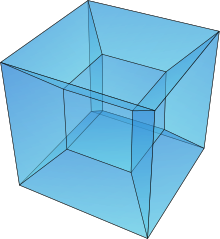Hypercube
- This article refers to the mathematical concept. For the movie of the same name, see Cube 2: Hypercube.



In geometry, a hypercube is an n-dimensional analogue of a square (n = 2) and a cube (n = 3). It is a closed, compact, convex figure consisting of groups of opposite parallel line segments aligned in each of the space's dimensions, at right angles to each other.
An n-dimensional hypercube is also called an n-cube. The term "measure polytope" (which is apparently due to Coxeter; see Coxeter 1973) is also used but it is rare.
A unit hypercube is a hypercube whose side has length one unit. Often, the hypercube whose corners (or vertices) are the 2n points in Rn with coordinates equal to 0 or 1 is called "the" unit hypercube.
A point is a hypercube of dimension zero. If one moves this point one unit length, it will sweep out a line segment, which is a unit hypercube of dimension one. If one moves this line segment its length in a perpendicular direction from itself; it sweeps out a two-dimensional square. If one moves the square one unit length in the direction perpendicular to the plane it lies on, it will generate a three-dimensional cube. This can be generalized to any number of dimensions. For example, if one moves the cube one unit length into the fourth dimension, it generates a 4-dimensional unit hypercube (a unit tesseract).
The hypercubes are one of the few families of regular polytopes that are represented in any number of dimensions. The dual polytope of a hypercube is called a cross-polytope. The 1-skeleton of a hypercube is a hypercube graph.
Elements
A hypercube of dimension n has 2n "sides" (a 1-dimensional line has 2 end points; a 2-dimensional square has 4 sides or edges; a 3-dimensional cube has 6 2-dimensional faces; a 4-dimensional tesseract has 8 cells). The number of vertices (points) of a hypercube is 2n (a cube has 23 vertices, for instance).
The number of m-dimensional hypercubes (just referred to as m-cube from here on) on the boundary of an n-cube is
For example, the boundary of a 4-cube contains 8 cubes, 24 squares, 32 lines and 16 vertices.
| n-cube | Graph | Names Schläfli symbol Coxeter-Dynkin |
Vertices (0-faces) |
Edges (1-faces) |
Faces (2-faces) |
Cells (3-faces) |
(4-faces) | (5-faces) | (6-faces) | (7-faces) | (8-faces) |
|---|---|---|---|---|---|---|---|---|---|---|---|
| 0-cube | 
|
Point - |
1 | ||||||||
| 1-cube | 
|
Digon {} or {2} |
2 | 1 | |||||||
| 2-cube | 
|
Square Tetragon {4} |
4 | 4 | 1 | ||||||
| 3-cube | Cube Hexahedron {4,3} |
8 | 12 | 6 | 1 | ||||||
| 4-cube | 
|
Tesseract octachoron {4,3,3} |
16 | 32 | 24 | 8 | 1 | ||||
| 5-cube | Penteract deca-5-tope {4,3,3,3} |
32 | 80 | 80 | 40 | 10 | 1 | ||||
| 6-cube | Hexeract dodeca-6-tope {4,3,3,3,3} |
64 | 192 | 240 | 160 | 60 | 12 | 1 | |||
| 7-cube | Hepteract tetradeca-7-tope {4,3,3,3,3,3} |
128 | 448 | 672 | 560 | 280 | 84 | 14 | 1 | ||
| 8-cube | Octeract hexadeca-8-tope {4,3,3,3,3,3,3} |
256 | 1024 | 1792 | 1792 | 1120 | 448 | 112 | 16 | 1 | |
| 9-cube | Eneneract octadeca-9-tope {4,3,3,3,3,3,3,3} |
512 | 2304 | 4608 | 5376 | 4032 | 2016 | 672 | 144 | 18 |
n-cube Rotation
Based on our observations of how 1, 2, and 3 dimensional objects can rotate, we can hypothesize how objects with n dimensions can rotate. A 3 dimensional object can rotate in 2 different ways, about 3 axes. The first way it can rotate is about an edge. A cube (as an example) can rotate about an entire edge, meaning that everything but that edge changes position. The second is about a single point. It's possible to rotate a cube around a single point, without that point changing its position. Similarly, a 2 dimensional object can rotate about a single point, but that's the only way it can rotate. So, a 3D cube can rotate about the 1st dimension or the 0th dimension, and a 2D plane can only rotate about the 0th dimension. So what about the 1st dimension? According to our theory, it would be able to revolve around the -1st dimension, which is nothingness, or nonexistent, which makes sense, because it can't rotate. This supports our theory for the first through third dimensions, so we can therefore assume that it will apply for all the other dimensions. This means that 4 dimensional hypercube can rotate about a whole face, and a 5-cube can rotate about a whole cube.
References
- Bowen, J. P., Hypercubes, Practical Computing, 5(4):97–99, April 1982.
- Coxeter, H. S. M., Regular Polytopes. 3rd edition, Dover, 1973, p. 123. ISBN 0-486-61480-8. p.296, Table I (iii): Regular Polytopes, three regular polytopes in n-dimensions (n>=5)
External links
- Weisstein, Eric W. "Hypercube". MathWorld.
- Olshevsky, George. "Measure polytope". Glossary for Hyperspace. Archived from the original on 4 February 2007.
- Hypercube images (2D–15D)
- Animation of a Hypercube

